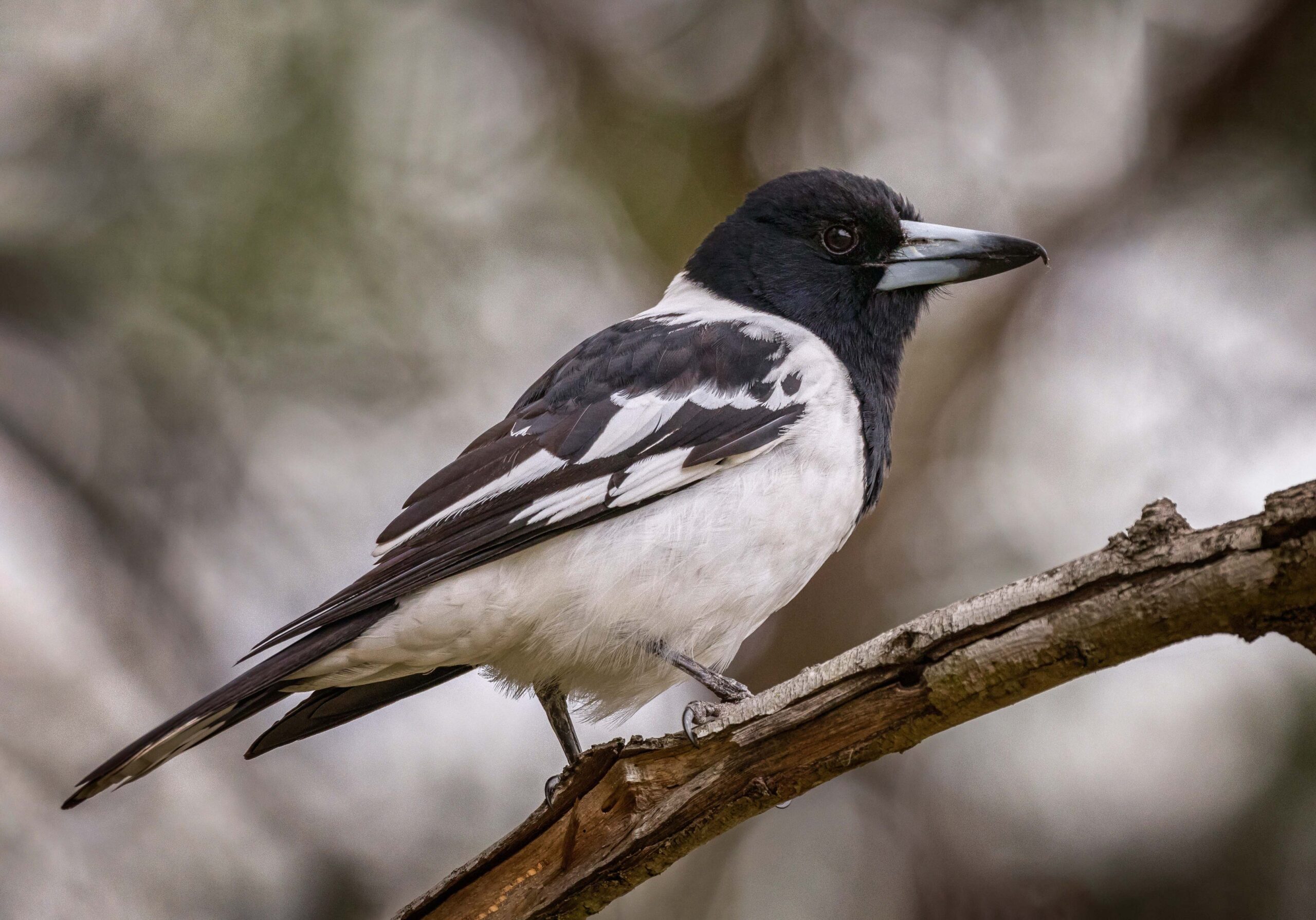At dawn in the Australian outback and woodland edges, the flute-like call of the Pied Butcherbird (Cracticus nigrogularis) fills the air. Revered as one of the most accomplished songbirds in the world, this species is celebrated not only for its striking black-and-white plumage but also for its complex, melodious voice. From the deserts of Western Australia to the woodlands of Queensland, the pied butcherbird is a sentinel of the open landscapes, its presence stitched into both natural soundscapes and cultural traditions.
Identification
The Pied Butcherbird is a medium-sized passerine, measuring 28–32 cm in length. Its plumage is boldly patterned, with glossy black on the head, breast band, back and tail, contrasted against a clean white collar, underparts and wing patches. The robust, hooked bill is pale bluish-grey tipped black – a signature feature of butcherbirds, adapted for grasping and tearing prey. Its bright, intelligent eyes and upright posture give it a commanding presence. Juveniles differ in appearance, with brownish plumage and a buff wash that fades as they mature.
Habitat and Distribution
Cracticus nigrogularis is found across most of mainland Australia, favouring open habitats such as dry eucalypt woodlands, acacia shrublands, grasslands with scattered trees and semi-arid regions. It is absent from the densest rainforests and the most arid central deserts but thrives in farmlands and peri-urban areas with scattered trees. The species occurs in both Queensland and Western Australia, reflecting its adaptability to a wide range of environments.
Ecological Role
As an opportunistic carnivore, the Pied Butcherbird feeds on insects, small reptiles, birds, mammals and occasionally carrion. It earns its name from its habit of impaling prey on thorns, branches, or wire fences, storing food for later consumption. By preying on a wide range of small vertebrates and invertebrates, it plays a regulatory role in ecosystems. Additionally, as a songbird, it contributes significantly to the acoustic landscape, with complex vocalisations that have inspired human music and been recorded in scientific studies of animal communication.
Behaviour and Reproduction
The Pied Butcherbird is territorial and often observed perched prominently on fence posts, dead branches, or powerlines, where it can survey its surroundings. Its song is varied and melodic, often performed at dawn or dusk and includes mimicry of other species.
Breeding occurs from winter into spring, varying with region. The nest is a neatly constructed bowl of twigs, placed high in a tree fork. Clutches usually contain 2-5 eggs, incubated by the female while the male provides food. Cooperative breeding has been observed, with helper birds assisting in raising chicks. The young fledge after about four weeks but may remain with the family group for months.
Conservation Status
The Pied Butcherbird is listed as Least Concern under both the Biodiversity Conservation Act 2016 (Western Australia) and the Nature Conservation Act 1992 (Queensland). It is common and widespread, with populations considered secure across its broad range.
Threats
Though secure overall, local populations can be impacted by habitat loss, particularly the removal of large trees that provide nesting sites. Vehicle collisions and secondary poisoning from rodenticides pose risks in agricultural and urban settings. Predation by cats also affects juvenile survival. Climate change and shifting rainfall patterns may alter insect availability in some habitats, potentially influencing foraging success.
Conservation Efforts
Because the species remains widespread, no targeted conservation measures are currently necessary. Its adaptability to modified landscapes has helped it persist even where other woodland birds have declined. Conservation actions that maintain large trees and open woodlands indirectly benefit the species. Community engagement through citizen science bird counts continues to monitor population trends, ensuring that this iconic songbird remains secure.
Final Thoughts
The Pied Butcherbird is more than a striking black-and-white sentinel of Australia’s open country – it is one of the finest songsters of the natural world, its music resonating through forests, farms and deserts alike. Protecting Cracticus nigrogularis is about safeguarding not just a bird, but a piece of Australia’s natural soundtrack, where beauty and survival are expressed in song.
Fauna Resources specialises in the safe handling of a range of different fauna species, through safe, effective and ethical fauna solutions. By providing dedicated fauna services, through passionate fauna spotter catchers and fauna specialists, we can support the unique terrestrial ecosystems and rich biodiversity Australia has to offer.
For more information about our specialist fauna services contact Fauna Resources today.

